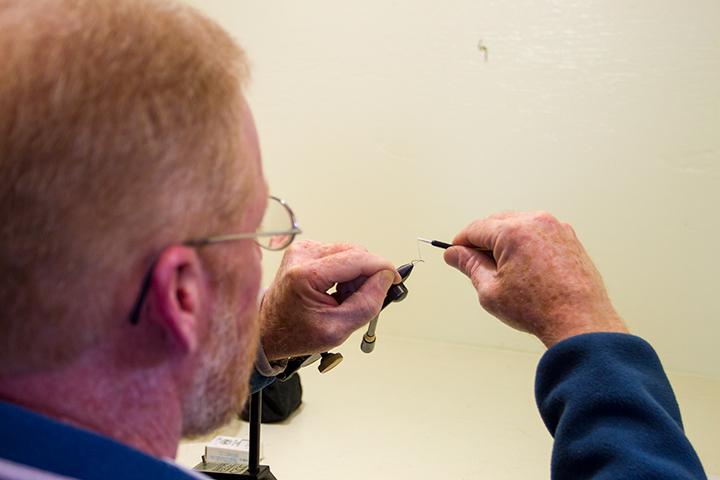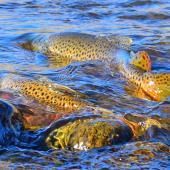Totally Tubular
How to tie the One Sock.
When the heat begins to wane and the leaves start to show autumn color, it means only one thing: time to start throwing streamers. It's one of the most productive and exciting ways to pursue big, aggressive trout, and the One Sock is one of my favorite patterns.
I originally tied this fly for the Big Hole River, but it's been successful in other local rivers. The best technique is to cast it tight to the riverbank, then strip it back quickly to bring it to life. The One Sock's articulation gives it phenomenal swimming action, making it nearly irresistible to hungry trout.
Tying the One Sock is a little time-consuming but worth the effort. Start by creating a dubbing loop, which is the body of the fly. Place a #2 hook in a rotating vice and run a 14-inch piece of copper wire through the eye of the hook until you reach the center of the wire.
Lay one end of the wire flat across a platform. Place a half-inch strip of light brown dubbing over top of the entire seven inches of wire. Lay several half-inch pieces of crystal flash evenly on the dubbing material. Lay the other half of the wire over the dubbing and crystal flash, grab the ends of the wires, and spin the vice until the material is uniformly distributed. Cut the wire from the hook and set the loop aside.
Now throw a #2 SC15 Gamakatsu hook (stinger hook) into your vice and, using flat-waxed nylon thread, create a small thread-based backbone. Part a rabbit strip one-quarter up from the end of the hide and attach the stinger hook. Add longevity by using Zap-A-Gap between the hook and strip.
Next, thread a 12-inch piece of 25-pound backing through the eye of the hook and place a cone head on a #4 long shank streamer hook. Using a bobbin threader, run both ends of the backing through the cone head opening on the hook, through the eye, and then back through the cone head in the opposite direction. Adjust the backing so that there is about three-quarters of an inch between the streamer hook and the stinger hook. Tightly wrap the backing onto the streamer shank with your thread.
Part the hair on the rabbit strip attached to the stinger hook. Using thread, attach it to the streamer hook exactly where the bend of the hook begins. Attach one end of your dubbing loop just in front of the rabbit strip. Tie four, three-inch-long rubber legs in pairs to the shank of the streamer hook one-quarter-inch apart from shank center. Wrap the dubbing loop around the shank until you have gone one-quarter-inch past the front legs and tie off. Bring the rest of the strip over the top of the dubbing loop and fasten it to the hook shank.
Wrap the tip of the marabou to the shank exactly where the rabbit strip was tied off and don't stop until you reach the end of the feather. Grab the marabou with your top three fingers, stretch it toward the back of the hook, and then wrap the head to bring the hackles back. Repeat with a red teal feather. There should be about a quarter-inch gap between the feather and the cone head. Tie three pieces of peacock hurl to the hook, right in front of the feather, and twist them around the shank until you reach the cone head. Whip-finish the thread and dab with Zap-A-Gap. Cut the streamer hook off behind where the rabbit strip is tied onto the shank. This helps create fluent motion and makes it an official single-hook fly.
Hold on tight and enjoy the ride!
Ingredients:
1. Medium Ultra Wire (Copper)
2. Danville's Flat Waxed Nylon Thread
3. Tiemco TMC 300 Size 4 Streamer Hook
4. Gamakatsu SC15 Saltwater Wide Gap Hook, Size 2
5. Tungsten Cone Head
6. Hareline Fur Dubbing (March Brown color)
7. Spirit River Lite-Brite Holographic Crystal Flash
8. 2" x 14" Natural Rabbit Strip (the fuller the better)
9. 1 Piece Long White Marabou
10. Teal Flank Feather (Red)
11. Peacock Hurl
12. Zap-A-Gap
Eric Thorson is co-owner of Sunrise Fly Shop in Melrose. He guides on the Big Hole, Beaverhead, Jefferson, and Madison rivers.
The Weekly Fly: Use your computer to catch more fish
By Melynda Harrison
Have you ever wanted to tie Dave McKee's Hairwing Callibaetis, Bob Jacklin's Giant Salmon Fly Nymph, Sylvester Nemes' Tup's Indispensible, or any other fly that might entice a trout to bite? TheWeeklyFly.com will teach you how. Each week the guys at Reel Action Media in Bozeman post a high-quality video demonstrating fly-tying patterns from well-known fly-tiers. They promise to add a fly a week until there are no more and they plan to add fish-related conservation videos by the end of the year.
The free library is searchable, useful, and easier than wading through a slew of websites looking for just the right fly. Users can also chat about the history and best uses of the fly, so not only will you walk away from your computer with a beautiful Gray Wulff, you'll know what to do with it. theweeklyfly.com.













